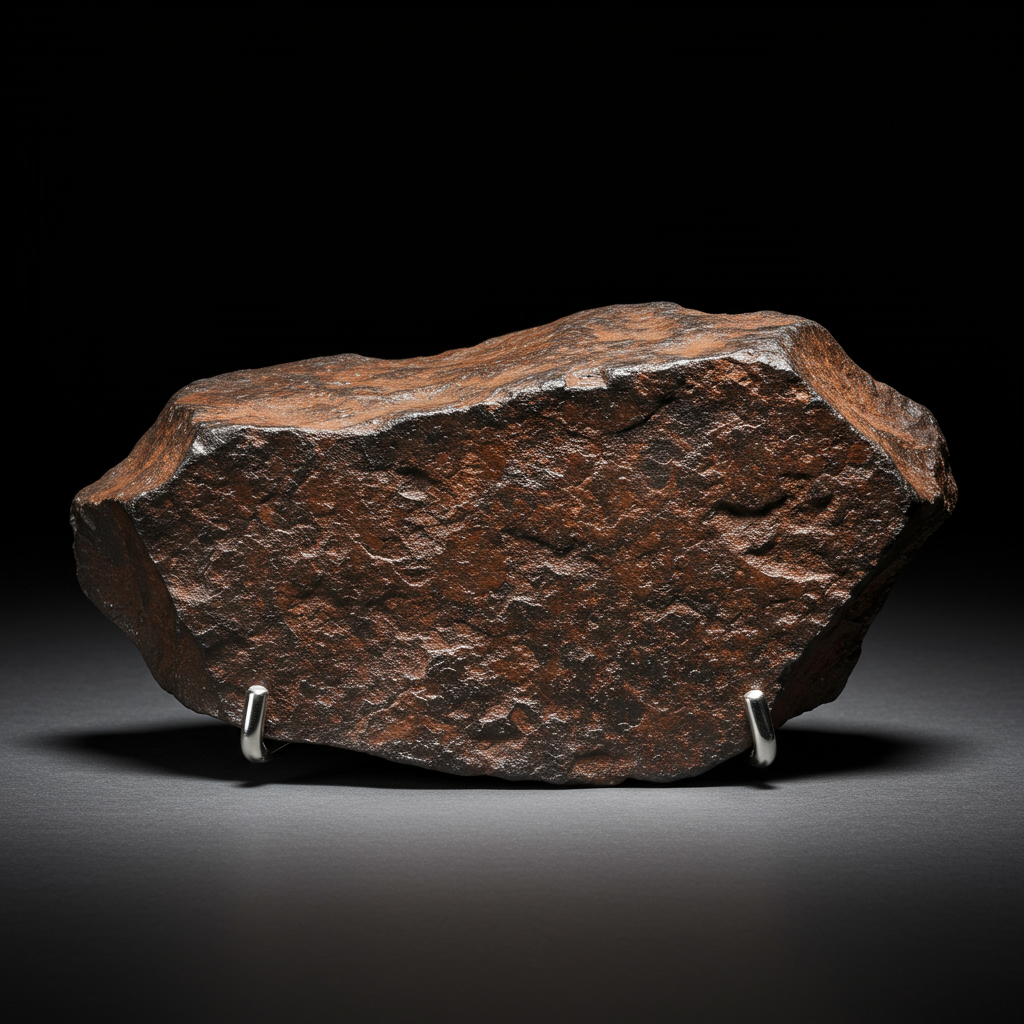Imagine holding a piece of another world in your hands. A single rock, originating from Mars, has been discovered that dwarfs all others previously found on Earth. This extraordinary specimen could soon fetch an astronomical sum at auction, potentially reaching US$4 million. It represents a direct connection to our neighboring planet, ejected from the martian surface millions of years ago.
Discovered in late 2023, this incredible meteorite, officially known as NWA-16788, holds the record as the most massive individual chunk of Mars recovered on our planet to date. Weighing in at a staggering 24.67 kilograms (approximately 54.39 pounds), it significantly surpasses the previous record holder. That earlier specimen, named Taoudenni 002, was found in Mali in 2021 and weighed only 14.51 kilograms. NWA-16788 is roughly 70 percent heavier, making its size truly remarkable.
The Incredible Journey to Earth
The story of NWA-16788 began not in a museum vault or a research lab, but in the vast, arid landscapes of the Agadez region in Niger. This sparsely populated area, located in the Sahara Desert, is perhaps more famous for its rich deposits of dinosaur fossils than for extraterrestrial visitors. Yet, in November 2023, a dedicated meteorite hunter made the find of a lifetime. This single, massive rock lay waiting to be discovered, a silent traveler from across the solar system.
Confirming a rock’s off-world origin requires rigorous scientific analysis. For NWA-16788, a small sample was sent to the Shanghai Astronomy Museum. Experts there meticulously examined its composition and structure. Their findings definitively confirmed its identity: this was no ordinary terrestrial rock. It was a piece of Mars, blasted into space by a powerful impact event.
What Makes This Martian Rock Unique?
The Sotheby’s listing for NWA-16788 highlights several key features contributing to its scientific value and estimated price tag. One crucial characteristic is its minimal terrestrial weathering. This indicates that its physical and chemical makeup has not been significantly altered since its arrival in the Sahara Desert environment. In simpler terms, the rock hasn’t spent a long time on Earth’s surface being eroded by wind and water. This suggests it likely fell from space relatively recently compared to many other meteorites.
Analyzing the internal structure and composition provides further clues about its history. NWA-16788 contains a high percentage of maskelynite, a type of glass formed only under extreme shock pressure. The presence of shock-melted areas within the rock strongly suggests a violent event. Scientists believe a severe asteroid collision on Mars was powerful enough to eject material from the planet’s surface. This rock was part of that ejected debris, sent flying into space.
The meteorite itself formed deep within Mars. According to the Sotheby’s description, it originated from the slow cooling of Martian magma. This process gives it a distinctive coarse-grained texture. Its primary mineral composition includes pyroxene, maskelynite, and olivine. These minerals are common components of Martian basalts, providing further confirmation of its origin.
Rarity and Value: A Piece of Another World
Finding any meteorite is a significant event. Identifying one that comes from a specific planet like Mars is exceptionally rare. Out of roughly 77,000 meteorites recognized and cataloged on Earth, only about 400 have been definitively identified as Martian in origin. This makes NWA-16788 one of a very small, elite group. Its immense size elevates its status even further, making it a truly once-in-a-generation discovery.
The estimated value of up to US$4 million reflects not only its scientific importance but also its incredible rarity and collector appeal. Pieces of Mars are highly sought after by both scientific institutions and private collectors. This particular specimen’s record-breaking weight positions it as arguably the most desirable Martian sample available outside of material collected directly by space missions.
The Debate: Museum or Private Collection?
The impending auction of such a scientifically important specimen has sparked debate within the planetary science community. Some experts argue passionately that NWA-16788 belongs in a public institution. Paleontologist Steve Brusatte from the University of Edinburgh voiced this concern, telling CNN, “It would be a shame if it disappeared into the vault of an oligarch.” He believes it should be in “a museum, where it can be studied, and where it can be enjoyed by children and families and the public at large.”
However, other scientists offer a different perspective. Planetary scientist Julia Cartwright from the University of Leicester shared her view with CNN. She suggested that scientific interest would remain regardless of who owns the rock. A private owner might even facilitate scientific study. Cartwright expressed optimism, stating, “we may still gather lots of science from this” even if it goes into a private collection.
This discussion highlights the tension between the scientific imperative to study rare extraterrestrial materials and the reality of a commercial market for such unique objects. Whether housed in a museum or a private collection, the scientific information contained within NWA-16788 is immense.
Adding Context: Mars’s Dynamic Geology
The discovery of NWA-16788 adds another layer to our understanding of Mars’s dynamic geological past. While this meteorite tells a story of ancient magma and violent impacts, other discoveries on Mars itself continue to reveal unexpected features. For instance, the NASA Curiosity rover recently made a surprising find in the Gediz Vallis Channel on Mars. Accidentally cracking open a rock, Curiosity discovered bright yellow crystals of pure elemental sulfur.
Finding elemental sulfur was unexpected because sulfates, compounds of sulfur typically formed in water, are more common. This discovery suggests the presence of pure sulfur might be more widespread in certain Martian regions than previously thought. It points to conditions on Mars that scientists don’t yet fully understand, adding another piece to the complex puzzle of the planet’s geological evolution. Like the NWA-16788 meteorite, such finds, whether on Mars or Earth, underscore that our knowledge of the Red Planet is constantly expanding.
The Auction Details
For those interested in the fate of this incredible extraterrestrial artifact, the opportunity to acquire it or simply witness its sale is approaching. Sotheby’s New York is handling the auction of the NWA-16788 meteorite. The bidding is scheduled to commence on July 16, 2025, at 14:00 UTC. The event is expected to attract significant attention from museums, research institutions, and private collectors worldwide, all vying for a chance to own a tangible piece of the Red Planet.
Frequently Asked Questions
What is the largest Mars meteorite discovered on Earth?
The largest single piece of Mars ever found on Earth is the meteorite officially designated NWA-16788. It weighs 24.67 kilograms (54.39 pounds), making it significantly heavier than the previous record holder. This massive Martian meteorite was discovered in Niger in November 2023 and has been confirmed as originating from the Red Planet through scientific analysis, including study at the Shanghai Astronomy Museum.
Where and when is the NWA-16788 meteorite being auctioned?
The record-breaking NWA-16788 Mars meteorite is being offered for sale by Sotheby’s. The auction is scheduled to take place at Sotheby’s New York. Bidding is set to begin on July 16, 2025, starting at 14:00 UTC (Coordinated Universal Time). It is anticipated to attract global interest due to the specimen’s rarity and scientific importance.
Why is the NWA-16788 meteorite estimated to be worth up to $4 million?
The high estimated value of the NWA-16788 meteorite, up to US$4 million, is due to several factors. Primarily, it is the largest single piece of Mars ever recovered on Earth, making it incredibly rare. Its excellent state of preservation, showing minimal terrestrial weathering, adds to its scientific value. Furthermore, its composition, including maskelynite from impact shock and minerals formed from Martian magma, confirms its authentic extraterrestrial origin and provides rich data for study. The combination of unique size, rarity, condition, and scientific interest drives its high market price.
In conclusion, the NWA-16788 meteorite represents a remarkable convergence of planetary science, discovery, and the unique market for extraterrestrial artifacts. This giant Mars rock, potentially worth millions, offers an unparalleled opportunity to study the geology of another world right here on Earth. Its sale highlights the fascinating journey of rocks from Mars to the Sahara Desert and sparks important conversations about the future of such invaluable scientific treasures. Regardless of who ultimately acquires it, this Martian visitor will continue to captivate imaginations and contribute to our ever-growing understanding of the Red Planet.




